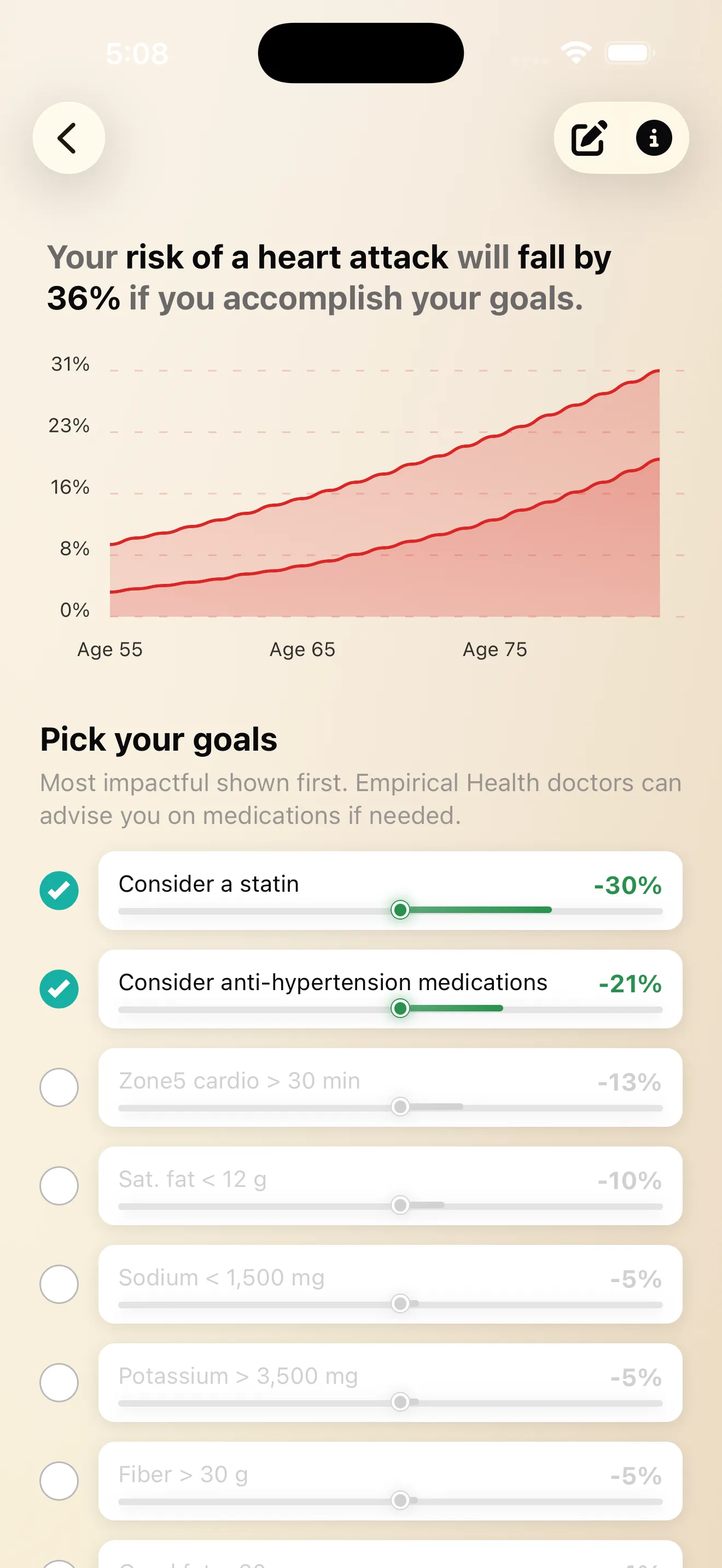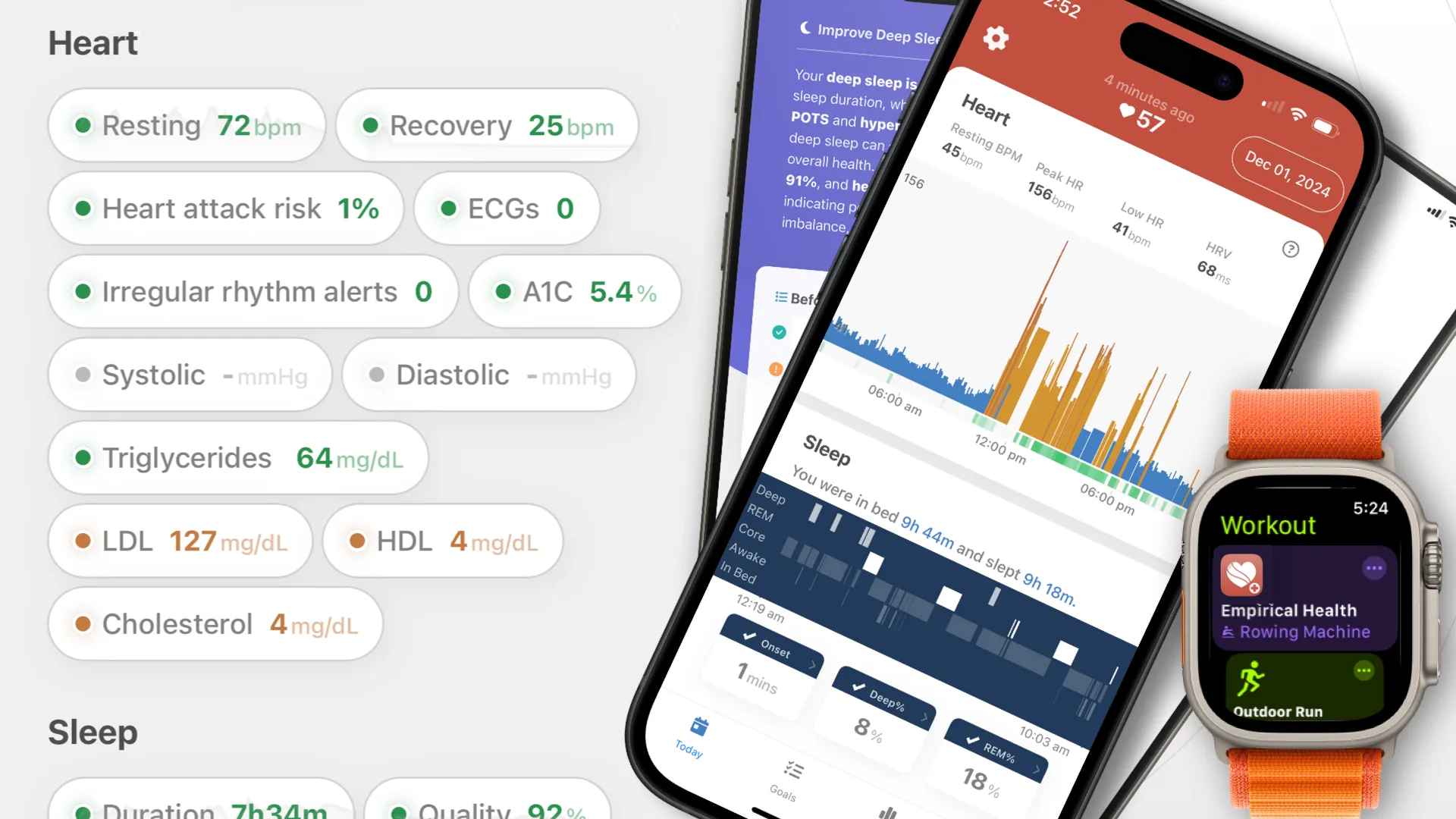Heart disease is the #1 cause of death worldwide — but doesn’t have to be. Your risk is highly modifiable. And thanks to decades of scientific research, we can not just project your cardiac risk, we can also simulate how specific lifestyle and medical interventions can reduce that risk.
This post focuses on the methodology behind projecting and visualizing changes to your lifetime heart attack risk. We’ll briefly introduce the key biomarkers and risk models, but our main goal is to show how you can use simulation to see the relative impact of interventions like improved nutrition, exercise, or medications.

From Risk Estimation to Simulation
Traditional heart attack risk calculators—like the Framingham, ASCVD, and Lifetime Risk models—combine a handful of biomarkers and health factors (such as cholesterol, blood pressure, diabetes, and smoking status) to estimate your probability of a heart attack over 10 years or your entire lifetime. These models are based on large population studies and validated statistical methods.
But what if you want to go beyond a static risk number? What if you want to project how your risk would change if you lower your blood pressure, improve your cholesterol, quit smoking, or start a medication?
That’s where simulation comes in.
The Methodology: Projecting Lifetime Risk
Simulating reductions in lifetime heart attack risk involves three main steps:
-
Baseline Risk Calculation:
Start with your current biomarker values (e.g., total cholesterol, systolic/diastolic blood pressure, diabetes status, smoking status, BMI). Plug these into a validated lifetime risk model, such as the ones we covered here (these risk models are used in the Empirical Health app). -
Modeling Interventions:
Adjust one or more input variables to reflect a potential intervention. For example:- Lowering systolic blood pressure by 10 mmHg (via medication or lifestyle)
- Reducing total cholesterol by 30 mg/dL (through diet, statins, or both)
- Quitting smoking
- Improving diabetes control (lowering A1c)
- Losing weight (lowering BMI)
Each change is plugged back into the risk model to generate a new projected risk.
-
Visualization:
The results are visualized—often as a bar chart or risk curve—so you can see the relative impact of each intervention, or combinations of interventions, on your lifetime risk. This helps you prioritize which changes will have the biggest effect for you.
Example: Simulating Interventions
Suppose your baseline lifetime risk of a heart attack is 46%. Here’s how your risk might change with different interventions:
| Scenario | Lifetime Risk |
|---|---|
| Baseline (elevated BP, high cholesterol, smoker) | 46% |
| Lower BP by 10 mmHg | 38% |
| Lower cholesterol by 30 mg/dL | 35% |
| Quit smoking | 28% |
| All three interventions | 15% |
This approach makes it clear which interventions have the largest effect, and how combining them can dramatically reduce your risk.
Key Biomarkers and Inputs
While the simulation focuses on methodology, it’s important to know which inputs matter most. The most widely used lifetime risk models rely on:
- Total cholesterol, LDL cholesterol, or ApoB. ApoB is the best of these, but most statistical models use older cholesterol biomarkrers.
- Systolic and diastolic blood pressure
- Smoking status
- Diabetes status, or continuous HbA1c.
- BMI
Advanced models (like PREVENT) may also include:
- ApoB (a more precise measure of atherogenic particles)
- hs-CRP (inflammation marker)
- Lp(a) (genetic risk factor)
- eGFR (kidney function)
- Socioeconomic factors (e.g., zip code)
Why simulate? Comparing relative impacts of different
Static risk numbers are useful, but they don’t give you a sense of what’s possible or what’s.
Simulation lets you:
- See the relative impact of different interventions
- Set realistic, personalized goals
- Make informed decisions about lifestyle changes and medications
- Track your progress over time
Try It Yourself
Empirical Health’s app and advanced heart health panel let you input your biomarkers, simulate interventions, and visualize your projected lifetime risk. This empowers you to take control of your cardiovascular health with data-driven decisions.
 Empirical Health app: comprehensive heart health monitoring with Apple and Android watches
Empirical Health app: comprehensive heart health monitoring with Apple and Android watches
In future posts, we’ll dive deeper into how to choose and combine interventions, and how to interpret your simulation results to make the biggest impact on your long-term health.
Get your free 30-day heart health guide
Evidence-based steps to optimize your heart health.
